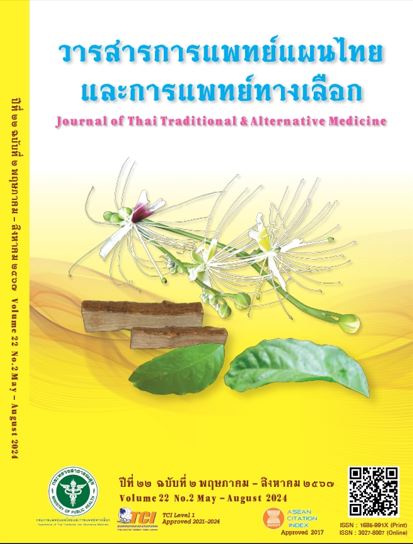ฤทธิ์ต้านอนุมูลอิสระและต้านการอักเสบของสารสกัดว่านม้าเหลือง
Main Article Content
บทคัดย่อ
บทนำและวัตถุประสงค์: ว่านม้าเหลือง (Curcuma sp.) อยู่ในวงศ์ Zingiberaceae เป็นสมุนไพรพื้นบ้านมีสรรพคุณช่วยแก้อาการปวดเมื่อย เคล็ดขัดยอก การศึกษานี้มีวัตถุประสงค์เพื่อศึกษาฤทธิ์ต้านอนุมูลอิสระและฤทธิ์ต้านการอักเสบของสารสกัดว่านม้าเหลือง
วิธีการศึกษา: นำสมุนไพรว่านม้าเหลือง จากตำบลคุ้งตะเภา จังหวัดอุตรดิตถ์ มาสกัดด้วยเทคนิคการหมักด้วยตัวทำละลายเมทานอล เอทานอล และการสกัดด้วยน้ำร้อนแบบไหลย้อนกลับ ศึกษาองค์ประกอบทางเคมีในสารสกัดว่านม้าเหลือง นำสารสกัดว่านม้าเหลืองมาทดสอบฤทธิ์ต้านอนุมูลอิสระโดยวิธี DPPH และ ABTS assay การทดสอบความเข้มข้นของสารสกัดต่ออัตราการอยู่รอดของเซลล์ และการทดสอบฤทธิ์ต้านการอักเสบจากกระบวนการเกิด nitric oxide (NO) ในเซลล์แมคโครฟาจ
ผลการศึกษา: การศึกษาองค์ประกอบทางเคมีด้วยวิธี LC-MS ของสารสกัดว่านม้าเหลืองด้วยเมทานอล เอทานอล และการสกัดน้ำร้อนแบบไหลย้อนกลับ (Reflux) พบสารที่มีคล้ายกัน คือสาร demethoxycurcumin และ curcumin การศึกษาฤทธิ์ต้านอนุมูลอิสระของสารสกัดว่านม้าเหลือง ด้วยเทคนิค DPPH เท่ากับ 0.63 ± 0.03, 0.76 ± 0.04 และ 1.31 ± 0.20 mg/ml ตามลำดับ และ การทดสอบด้วยเทคนิค ABTS เท่ากับ 169.00 ± 4.32, 136.55 ± 4.35 และ 70.83 ± 7.07 µM/g ตามลำดับ ผลการทดสอบสารสกัดว่านม้าเหลืองจากตัวทำละลายเอทานอล ไม่แสดงความเป็นพิษต่อเซลล์ที่ความเข้มข้นสูงสุด 10 µg/mL เป็นความเข้มข้นที่มีการอยู่รอดของเซลล์มากกว่า 90% และมีฤทธิ์ยับยั้ง NO ได้ร้อยละโดยเฉลี่ย 55.30
อภิปรายผล: จากการวิเคราะห์องค์ประกอบทางเคมีในสารสกัดว่าม้าเหลืองพบสารสำคัญในการสกัดด้วยตัวทำละลายเมทานอลมากที่สุด รองลงมาคือ เอทานอล และการสกัดน้ำร้อนแบบไหลย้อนกลับ ผลการเปรียบเทียบการวิเคราะห์สารสำคัญทั้ง 3 สารสกัดว่านม้าเหลืองด้วยตัวทำละลายที่แตกต่างกัน พบสารที่มีคล้ายกัน คือสาร curcumin และ demethoxycurcumin
ข้อสรุปและข้อเสนอแนะ: สารสกัดว่านม้าเหลืองมีฤทธิ์ต้านอนุมูลอิสระและฤทธิ์ต้านการอักเสบ สามารถนำองค์ความรู้ดังกล่าวไปพัฒนาต่อยอดเป็นผลิตภัณฑ์เพื่อเพิ่มมูลค่าว่านม้าเหลืองต่อไป
Article Details

อนุญาตภายใต้เงื่อนไข Creative Commons Attribution-NonCommercial-NoDerivatives 4.0 International License.
เอกสารอ้างอิง
Kanahum N. Wan Ma Lueang [Internet]. 2021 [cited 2023 November 9]. Available from: http://banvanthai.com
Kasetpraset O. Zingiberaceae plant family. Nonthaburi: Chumnum Saha Kor Kaset Co., Ltd.; 2007. (in Thai)
Sun W, Wang S, Zhao W, Wu C, Guo S, Gao H, Tao H, Lu J, Wang Y & Chen Y. Chemical constituents and biological research on plants in the genus curcuma. Critical Reviews in Food Science and Nutrition. 2016.
Niranjan A, Prakash D. Chemical constituents and biological activities of turmeric (Curcuma longa L.) - A review. J Food Sci Technol. 2008;45(2):109–16.
Li S, Yuan W, Deng G, Wang P, Yang P, BB A. Chemical composition and product quality control of turmeric (Curcuma longa L.). Pharmaceytical Crops. 2011;2:28-54.
Sehabuth V, Srisombut T. Application of Niosomes in the delivery of local herbal extracts to reduce pain and inflammation of osteoarthritis. PTU Journal of Science and Technology. 2020;1(1):69-82. (in Thai)
Basnet P, Skalko-Basnet N. Curcumin: an anti-inflammatory molecule from a curry spice on the path to cancer treatment. Molecules. 2011;16(6):4567-98.
Schaffer M, Schaffer PM, Zidan J, Sela GB. Curcuma as a functional food in the control of cancer and inflammation. Current Opinion in Clinical Nutrition & Metabolic Care. 2011;14(6):588-97.
Panthong A, Kanjanapothi D, Niwatananum V, Tuntiwachwuttikul P, Reutrakul V. Anti-inflammatory activity of compounds isolated from Zingiber cassumnar. Planta Med. 1990;56(6):655.
Jeenapongsa R, Yoovathaworn K, Sriwatanakul KM, Pongprayoon U, Sriwatanakul K. Anti-inflammatory activity of (E)-1-(3,4-dimethoxyphenyl) butadiene from Zingiber cassumunar Roxb. Journal of Ethnopharmacology. 2003;87(2-3):143-8.
Han AR, Kim MS, Jeong YH, Lee SK, Seo EK. Cyclooxygenase-2 inhibitory phenylbutenoids from the rhizomes of Zingiber cassumunar. Chem Pharm Bull. 2005;53(11):1466-8.
Niranjan A, Prakash D. Chemical constituents and biological activities of turmeric (Curcuma longa l.) -A review. Journal of Food Science and Technology. 2008;45(2):109−16.
Ouncharoen K, Leelananthakul W. Antioxidant and anti-inflammatory activities of Prasa Khamin-Oi remedy and its herbal components. Journal of Khon Kaen Provincial Health Office. 2022;4(2):225-38. (in Thai)
Lee SK, Lee SK, Hong CH, Huh SK, Kim SS, Oh OJ, Min HY, Park KK, Chung WY, Hwang JK. Suppressive effect of natural sesquiterpenoids on inducible cyclooxygenase (COX-2) and nitric oxide synthase (iNOS) activity in mouse macrophage cells. J Environ Pathol Toxicol Oncol. 2002;21(2):141-8.
Navarro Dde F, Navarro Dde F, Souza MMde, Neto RA, Golin V, Niero R, Yunes RA, Monache FD, Filho CV. Phytochemical analysis and analgesic properties of Curcuma zedoaria grown in Brazil. Phytomedicine. 2022;9(5):427-32.
Kaewpiboon C, Boonnak N. Biological activities of Curcuma zedoaria (Christm.) Roscoe. Thai Science and Technology Journal. 2022;30(2):1-13. (in Thai)


